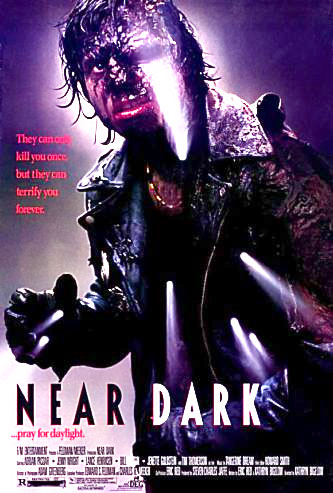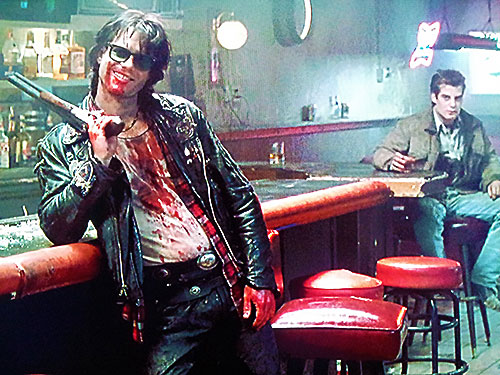 One of the great vampire movies, and in my view the best-ever film by director Kathryn Bigelow, a starkly violent yet poetic fever dream of romance and bloodletting. NEAR DARK (1987) was the final release of the short-lived De Laurentiis Entertainment Group. Its U.S. theatrical bow occurred around the same time as that of HELLRAISER, which was the bigger moneymaker—and also, it seemed, the better film. That’s no longer the case!
One of the great vampire movies, and in my view the best-ever film by director Kathryn Bigelow, a starkly violent yet poetic fever dream of romance and bloodletting. NEAR DARK (1987) was the final release of the short-lived De Laurentiis Entertainment Group. Its U.S. theatrical bow occurred around the same time as that of HELLRAISER, which was the bigger moneymaker—and also, it seemed, the better film. That’s no longer the case!
… poetic fever dream of romance and bloodletting.
Painter-turned-filmmaker Kathryn Bigelow made her solo directorial debut with NEAR DARK (following 1982’s THE LOVELESS, co-directed with Monty Montgomery). Its cast featured several James Cameron regulars (Lance Henriksen, Jenette Goldstein, Bill Paxton), which makes sense, as Cameron married Bigelow in 1989 and produced a couple of her films. Another notable collaborator on NEAR DARK was co-screenwriter Eric Red, who scripted THE HITCHER a year earlier and, again in collaboration with Bigelow, the Red-directed UNDERTOW (1996).
Subsequent Kathryn Bigelow productions include BLUE STEEL, POINT BREAK, STRANGE DAYS, THE WEIGHT OF WATER, K-19: THE WIDOWMAKER and THE HURT LOCKER, arguably the only one of her films to approach (but not surpass!) NEAR DARK.
One of the great vampire movies.
Caleb is a young punk who meets the gorgeous Mae outside a bar one night. What he doesn’t know is that Mae is a vampire intending to kill him and drink his blood. However, Mae finds herself strangely attracted to Caleb and so lets him live–well, sort of: she actually bites him on the neck, making him a vampire too. Shortly later, as the sun is coming up, Caleb and Mae are snatched by a gang of punked-out vampire drifters Mae runs with, who ride around the Arizona desert in a Winnebago. Their ranks include the patriarchal Jesse (who when asked his age replies, “Let’s just say I fought for the South…we lost”), his wife Diamondback, their grown-up son Severen, and Homer, a middle-aged man stuck in a child’s body.
As Caleb’s father and young sister search for him, he’s made a part of the vamps’ latest nocturnal killing spree. Victims include a truck driver, two young women and a gang of petty thieves. Later the gang enters a redneck bar and methodically slaughters nearly everyone inside. Caleb can’t bring himself to kill, and so lets the lone survivor of the massacre, a petrified young man, run off. The latter alerts the police, who converge upon the vampires at a cheap motel the following morning.
The infamous mid-film bar massacre remains one of Bigelow’s most impressive directorial achievements, a tightly controlled, tension filled and genuinely shocking cavalcade of carnage.
The vamps escape for a subsequent night of mayhem, ending up at another cheap motel where Caleb is inadvertently reunited with his father and sister. They whisk him away and Caleb’s father, a veterinarian, uses his medical expertise to cure Caleb’s vampirism via a blood transfusion. But Caleb still longs for Mae, and vice-versa. Nor are Mae’s vampire companions done with Caleb and his family, as a forthcoming highway showdown is about to prove…
In this early effort Kathryn Bigelow demonstrates a smooth and confident visual mastery in stark contrast to her later films, which tend to be excessively flashy and overdone. NEAR DARK has an undeniably artistic sensibility, yet still satisfies as a hard-edged thriller with plenty of wrenching violence. The infamous mid-film bar massacre remains one of Bigelow’s most impressive directorial achievements, a tightly controlled, tension filled and genuinely shocking cavalcade of carnage.
Particularly impressive is the way Bigelow makes quite a few hackneyed elements work in the film’s favor. Take the sparse desert locations, the staple of countless lame no-budgeters that through the lens of cinematographer Adam Greenberg take on an ethereal poetry. Or the moody synthesizer score by Tangerine Dream, the ruin of many an eighties flick (see THE KEEP and the U.S. cut of LEGEND) that here works superbly, imbuing the twilit imagery with a haunting aural beauty. Even the performances of B-movie mainstays like TRANCERS’ Tim Thomerson and Jenny Wright (the Hot Chick of quite a few eighties and early nineties movies) are first-rate, making Kathryn Bigelow the rare example of a visually oriented director who’s also great with actors.
There is, however, one not-so-great element about NEAR DARK: the ending. The idea of a blood transfusion as a cure for vampirism is scarcely plausible (especially in light of the immensely clever and resourceful twists on traditional vampire lore introduced in the rest of the film), and nor is the final highway showdown wherein the vamps meet their end (which was heavily criticized by none other than Anne Rice, who argued, convincingly, that centuries-old vampires would be canny enough to avoid such a fate). Still, the film overall is so fine I’m inclined to cut Bigelow some slack regarding the ending—although I’m fully aware that other viewers might not be so generous.
Vital Statistics
NEAR DARK
F/M Entertainment
Director: Kathryn Bigelow
Producer: Steven-Charles Jaffe
Screenplay: Kathryn Bigelow, Eric Red
Cinematography: Adam Greenberg
Editing: Howard Smith
Cast: Adrian Pasdar, Jenny Wright, Lance Henriksen, Bill Paxton, Jenette Goldstein, Tim Thomerson, Joshua Miller, Marcie Leeds, Kenny Call, Ed Corbett, James LeGros, Theresa Randle

